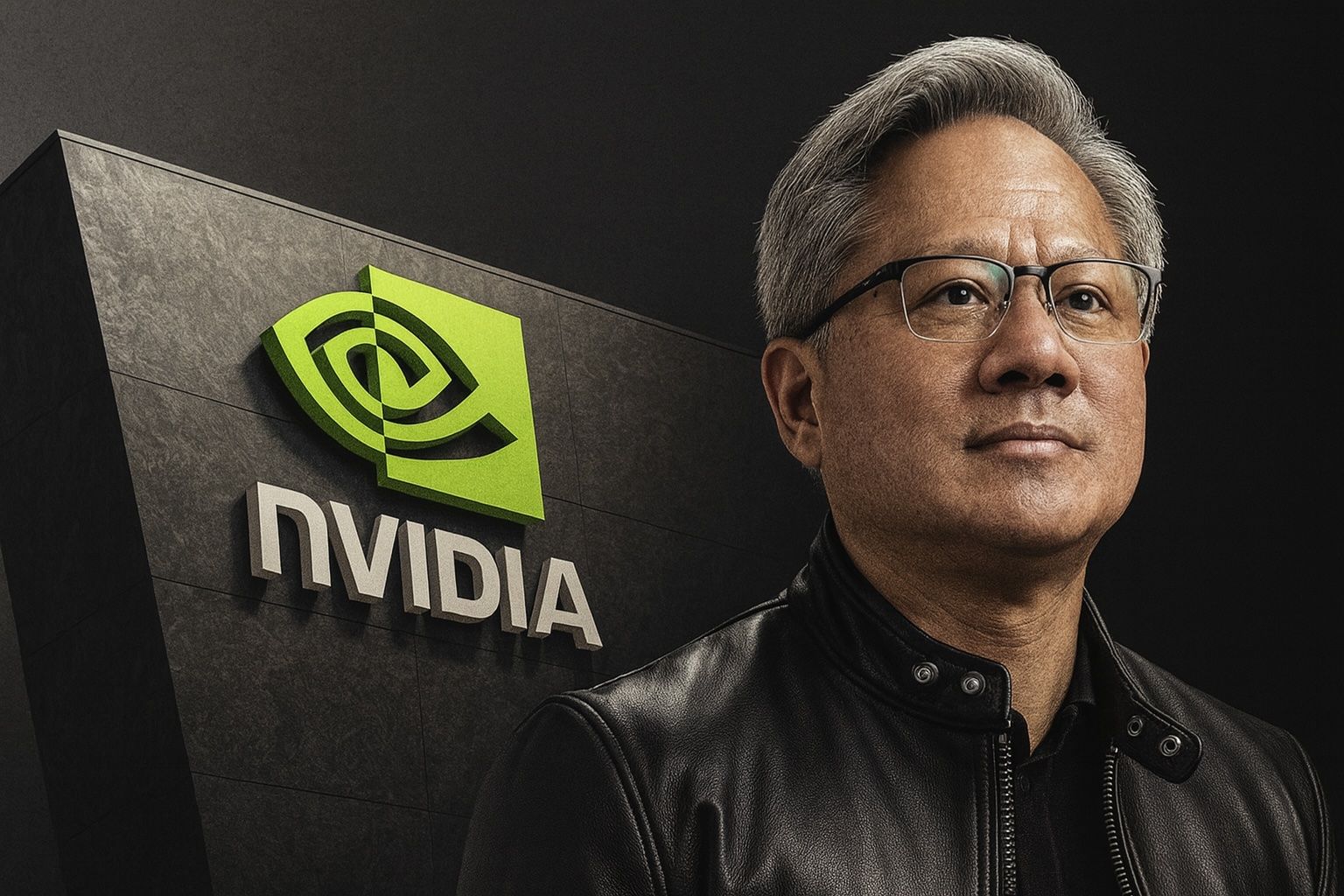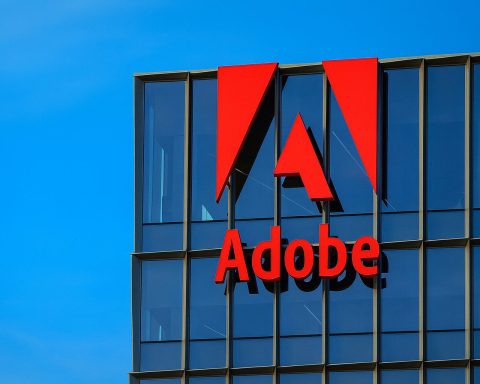Nvidia has once again turned the AI boom into blockbuster numbers. On Wednesday, November 19, 2025, the world’s most valuable public company reported record third‑quarter fiscal 2026 results that blew past Wall Street expectations and reinforced its status as the central supplier of AI computing power.
For a quarter that ended October 26, 2025, Nvidia posted $57.0 billion in revenue, up 22% quarter over quarter and 62% year over year, as demand for its AI data‑center chips remained insatiable. Adjusted earnings per share came in at $1.30, well ahead of the roughly $1.25–$1.26 consensus and above the $1.23–$1.26 range analysts had been using in pre‑earnings previews. [1]
Crucially, Nvidia guided for fourth‑quarter revenue of about $65 billion (±2%), far above the roughly $61.6 billionanalysts were expecting, signaling no let‑up in AI infrastructure spending. [2]
NVDA stock closed regular trading up around 3% near $186.50, then jumped more than 4% in after‑hours trading as investors digested the earnings beat and bullish guidance. [3]
Q3 FY2026 by the numbers: AI turns into cash
According to Nvidia’s earnings release and CFO commentary, the third quarter of fiscal 2026 (three months ended October 26, 2025) looked like this: [4]
- Total revenue: $57.0 billion
- +22% vs. Q2 FY26
- +62% vs. Q3 FY25
- GAAP gross margin: 73.4%
- Up 1.0 percentage point sequentially
- Down about 1.2 percentage points year over year as Nvidia ramps more complex systems
- GAAP net income: $31.9 billion
- GAAP diluted EPS: $1.30 (up ~67% year over year)
On a non‑GAAP basis, revenue is the same $57.0 billion, with non‑GAAP gross margin at 73.6% and non‑GAAP EPS also at $1.30, both comfortably ahead of consensus and prior-quarter levels. [5]
Nvidia’s cash machine is also spinning for shareholders: over the first nine months of fiscal 2026, the company returned $37.0 billion via buybacks and dividends, with $62.2 billion still left on its repurchase authorization. The next quarterly dividend of $0.01 per share is scheduled for December 26, 2025. [6]
Data Center is the engine: $51.2 billion and ‘sold out’ GPUs
As in recent quarters, Nvidia’s Data Center division did almost all the heavy lifting.
- Data Center revenue: $51.2 billion, up 25% quarter over quarter and 66% year over year, setting yet another record. [7]
This segment houses the company’s flagship AI accelerators built on its Blackwell and Rubin architectures, networking products like Spectrum‑X, and AI‑focused CPUs and systems. Management said demand remains so strong that:
Blackwell sales are “off the charts,” and cloud GPUs are “sold out,”
reiterating comments from CEO Jensen Huang in the release and early commentary. [8]
The quarter also saw Nvidia deepen its web of partnerships:
- A strategic partnership with OpenAI to deploy at least 10 gigawatts of Nvidia systems for the AI startup’s next‑generation infrastructure. [9]
- Expanded collaborations with Google Cloud, Microsoft, Oracle and xAI to build out “America’s AI infrastructure” with hundreds of thousands of Nvidia GPUs. [10]
- New AI infrastructure initiatives in the U.K., Germany and South Korea, including a £2 billion investment in the U.K. and plans to deploy over a quarter‑million GPUs with Korean partners such as Hyundai, Samsung and SK Group. [11]
Taken together, these efforts reinforce why Huang has previously talked about more than $500 billion in AI chip bookings through 2026, and why the company now sees a path to well over $200 billion in full‑year fiscal 2026 revenue if guidance trends hold. [12]
Gaming, Pro Visualization and Automotive: smaller, but still growing
While AI data centers dominate the story, Nvidia’s other businesses are far from standing still. Segment details from the quarter: [13]
- Gaming and AI PC
- Revenue: $4.3 billion
- Down 1% sequentially but up 30% year over year
- Benefiting from RTX‑powered titles and AI‑enhanced PC features, as Nvidia positions its GeForce ecosystem for on‑device AI.
- Professional Visualization
- Revenue: $760 million
- Up 26% quarter over quarter and 56% year over year
- Helped by the launch of DGX Spark, billed as the world’s smallest AI supercomputer for enterprises.
- Automotive and Robotics
- Revenue: $592 million
- Up 1% sequentially and 32% year over year
- Supported by new platforms like DRIVE AGX Hyperion 10 and robotics initiatives tied to “physical AI” and digital twins.
The growth outside data centers matters for Nvidia’s long‑term story: it shows that AI is bleeding into cars, factories, and design workflows, not just cloud megadata centers.
Guidance: Nvidia tells Wall Street the AI wave isn’t cresting yet
If Q3 answered the question “Is AI demand still strong?”, Nvidia’s Q4 forecast tried to tackle “How long can this last?”
For the fourth quarter of fiscal 2026, Nvidia expects: [14]
- Revenue: about $65.0 billion (±2%)
- Street was looking for roughly $61.6 billion, so guidance is significantly above consensus.
- Gross margin: about 75% non‑GAAP (74.8% GAAP), ±50 basis points.
- Operating expenses: around $5.0 billion non‑GAAP (and $6.7 billion GAAP).
Reuters notes that this outlook again positions Nvidia as the key test for whether the staggering AI capex plans of cloud providers—Microsoft alone spent nearly $35 billion in capex last quarter, roughly half on chips—are backed by real, sustainable demand. [15]
Options traders had been bracing for a 7% move in Nvidia’s share price in either direction after earnings, implying a potential market‑value swing of more than $300 billion for a company now worth around $4.5–4.6 trillion and accounting for roughly 8% of the S&P 500. [16]
So far, the reaction has been positive rather than euphoric: a pop of about 4% in extended trading suggests that Nvidia cleared a very high bar, but didn’t ignite a full‑blown melt‑up—at least not yet. [17]
Bubble or breakout? Anxious market gets a temporary answer
Heading into today’s report, Nvidia had become ground zero for the AI bubble debate.
- The stock had fallen nearly 8% in November, even after a roughly 1,200% surge over the past three years, as investors questioned whether AI valuations had run too far. [18]
- High‑profile investors including Peter Thiel’s fund and SoftBank’s Masayoshi Son had sold their stakes in Nvidia, rotating into other AI bets such as OpenAI. [19]
- The Cboe Volatility Index (VIX) climbed toward 25, and CNN’s Fear & Greed Index slid into “Extreme Fear,” reflecting broader market jitters. [20]
- A Bank of America fund manager survey found that 45% of participants now see an AI bubble as the single biggest tail risk to markets, up sharply from just over 10% in September. [21]
Against that backdrop, Nvidia’s Q3 FY2026 numbers offer at least one clear message: so far, the fundamentals are still keeping up with the hype. Revenue hasn’t just grown—it’s accelerated well above the already lofty expectations, and bookings plus guidance point to continued momentum into 2026.
That doesn’t settle the bubble question entirely. But it does make it harder to argue that AI infrastructure spending is purely speculative, at least in the near term.
‘Circular’ AI mega‑deals draw scrutiny
One of the touchiest topics surrounding Nvidia’s success is how much of today’s demand is organic and how much is “circular”—created by complex, multi‑party deal structures.
Investopedia’s live coverage and Business Insider’s reporting highlight several recent arrangements that worry skeptics: [22]
- OpenAI and Nvidia
- Nvidia has agreed to invest up to $100 billion in OpenAI.
- OpenAI, in turn, has committed to buy or lease 10 gigawatts of Nvidia‑powered AI data centers.
- It has also agreed to procure 6 gigawatts of chips from AMD, receiving warrants that could give it close to a 10% stake in OpenAI.
- Anthropic, Microsoft and Nvidia
- A massive three‑way partnership sees Nvidia and Microsoft investing up to $10 billion and $5 billionrespectively in Anthropic.
- Anthropic committed to spend $30 billion on compute and to purchase up to 1 gigawatt of capacity built on Nvidia’s Grace Blackwell and Vera Rubin systems, running on Microsoft Azure.
- CoreWeave and other AI cloud providers
- Nvidia increased its stake in CoreWeave when it went public, and separately agreed to buy all of CoreWeave’s excess cloud capacity through 2032. [23]
Deals like these blur the line between customer and investor. As Ben Reitzes of Melius Research told CNBC, Nvidia CEO Jensen Huang will be under pressure to explain the “circular deal mentality” and articulate how these gigantic commitments translate into durable, profitable AI usage rather than simply propping up current‑period revenue. [24]
Supply chain shock: Nvidia’s memory shift could double server‑memory prices
On the same day as its earnings release, Nvidia also made headlines for a quiet but consequential design change that could reshape semiconductor supply chains.
According to a new report highlighted by Reuters, Nvidia is moving some of its AI servers to LPDDR memory, a low‑power chip normally found in smartphones and tablets, instead of traditional server‑class DDR5. Because AI servers require far more memory chips than handsets, Counterpoint Research warns that this pivot could double server‑memory prices by the end of 2026 and lift overall memory prices by around 50% through mid‑2026. [25]
Memory giants Samsung, SK Hynix and Micron are already dealing with shortages of legacy DRAM after refocusing capacity on high‑bandwidth memory required for AI accelerators. Nvidia’s move to LPDDR adds another powerful source of demand, potentially squeezing cloud providers and AI startups that are already grappling with soaring hardware and power costs. [26]
If Nvidia’s GPUs are the “brains” of the AI boom, memory chips are the critical short‑term bottleneck. Rising memory prices could eventually pressure margins for hyperscale cloud operators—even as Nvidia itself continues to enjoy gross margins in the mid‑70% range.
Geopolitics and the Saudi AI push: Huang on the global stage
Nvidia’s influence now extends well beyond Silicon Valley and Wall Street. On the same day it reported earnings, CEO Jensen Huang appeared at the U.S.–Saudi Investment Forum at Washington’s Kennedy Center alongside Tesla’s Elon Musk and U.S. President Donald Trump, in a high‑profile discussion on AI and future technologies. [27]
Saudi Arabia is pushing aggressively to become a third global AI powerhouse through its Public Investment Fund and new AI infrastructure company Humain, which has signed major deals to source advanced Nvidia GPUs for a planned 500‑megawatt AI data‑center initiative. [28]
For Nvidia, such forums underline how its chips have become a strategic asset in geopolitics, tied up with energy policy, data‑center location decisions and cross‑border investment flows. They also introduce new risks: regulatory scrutiny, export controls (especially around China), and potential backlash if AI deployments intersect with contentious political issues. [29]
Key questions for investors after Nvidia’s blowout quarter
Even after a record $57 billion quarter and bullish guidance, Nvidia hasn’t eliminated uncertainty—it’s just reshaped it. Here are the main issues market participants will be watching in the wake of today’s results:
- Can AI capex stay this high?
Big Tech’s capital spending on AI data centers—Microsoft alone at ~$35 billion last quarter—is extraordinary. The bull case is that AI helps drive productivity gains across industries, justifying the spend. The bear case is that companies are overbuilding capacity and could eventually slam the brakes, leaving Nvidia with a demand air pocket. [30] - Is the “circular deals” risk manageable?
Nvidia’s massive investments in OpenAI, Anthropic, CoreWeave and others tie revenue and demand closely to a small group of AI leaders. Investors will be watching the company’s balance sheet, free cash flow, and non‑AI revenue streams for signs that growth is not purely fueled by vendor‑financed loops. [31] - How long do GPUs actually remain useful?
Short‑sellers such as Michael Burry have argued that AI GPUs may become obsolete in one to two years, creating an accounting mismatch for cloud providers that depreciate them over five or six years. Others counter that resale markets and software optimizations extend the useful life of older chips far more than skeptics assume. [32] - Can Nvidia navigate export controls and geopolitical pressure?
U.S. restrictions prevent Nvidia from selling its most advanced chips into China, and Huang has said there are “no active discussions” on shipping Blackwell there, even in scaled‑down form. At the same time, demand from U.S. allies (in Europe, the Middle East and Asia) is rising. The question is whether growth elsewhere can continue to offset lost Chinese demand. [33] - What happens to margins as systems get more complex?
Analysts expect gross margins to stay high but face pressure as Nvidia delivers larger, more integrated systems and navigates capacity constraints at partners like TSMC, along with rising memory and power costs. Q3’s slight year‑on‑year margin compression is a reminder that even dominant suppliers aren’t immune to physics and manufacturing realities. [34]
Bottom line: AI boom intact—for now
Today’s Q3 FY2026 earnings report did what Nvidia needed it to do, and then some.
- It validated the scale of AI demand with revenue and EPS that beat already‑optimistic expectations.
- It reassured investors about the near‑term outlook via stronger‑than‑expected Q4 guidance and huge bookings through 2026.
- It kept Nvidia at the center of every major AI conversation, from hyperscale cloud capex to Saudi‑U.S. investment ties and global memory supply chains.
At the same time, the very magnitude of these numbers—and the intricate web of multibillion‑dollar AI deals surrounding them—means that Nvidia will remain the market’s focal point for debates about bubbles, sustainability and the long‑term payoff of AI.
For now, though, the message from the world’s most valuable chipmaker is clear: the AI train is still at full speed, and Nvidia is driving the locomotive.
References
1. www.quiverquant.com, 2. www.quiverquant.com, 3. www.investors.com, 4. www.quiverquant.com, 5. www.quiverquant.com, 6. www.quiverquant.com, 7. www.stocktitan.net, 8. www.quiverquant.com, 9. www.stocktitan.net, 10. www.stocktitan.net, 11. www.quiverquant.com, 12. www.reuters.com, 13. www.quiverquant.com, 14. www.quiverquant.com, 15. www.reuters.com, 16. www.reuters.com, 17. seekingalpha.com, 18. www.reuters.com, 19. www.reuters.com, 20. www.investopedia.com, 21. www.investopedia.com, 22. www.investopedia.com, 23. www.investopedia.com, 24. www.investopedia.com, 25. www.reuters.com, 26. www.reuters.com, 27. www.reuters.com, 28. en.wikipedia.org, 29. www.reuters.com, 30. www.reuters.com, 31. www.investopedia.com, 32. www.reuters.com, 33. www.reuters.com, 34. www.reuters.com










